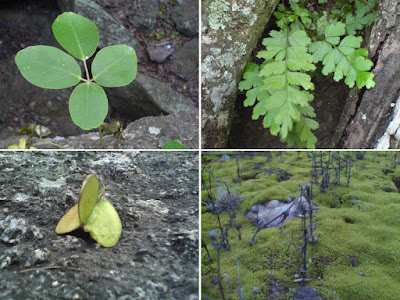I'd almost forgotten about this trip until I stumbled on the pictures which brought back memories of the day.
December 8, 2007
I'd been on a visit to Bangalore. As usual Deepak, Gulveer and I met up which somehow resulted in planning a trip to our beloved hill- Savandurga. For a change we decided on night camping on the hill. We left Bangalore after lunch. We took Bangalore-Magadi-Savandurga road instead of Bangalore-Dodda Alada Mara-Savandurga. The latter is much more scenic but the former is quicker. We stopped for a short break when the monolith appeared on the horizon, as if it was welcoming us. This stretch of the road was flanked by paddy fields, crop almost ready for harvest.
We went into the "battada gadde" to take a closer look at the plants. Rajesh poses for a picture of himself with Batta and Savandurga. The green-yellow shade is a treat to the eyes. A month ago the field would have been thoroughly wet and the plants greener.
We reached Savandurga by 4-30. Parked our car at Veerabhadreshwara Devastana, had a word with the priest about our plan to stay at the top. It's always good that locals knew of our stay. This is one of the few surviving ancient temples still in the original condition. The architecture is Vijayanagara. These temples were built by Palyegar rulers who were vassals of Vijayanagara empire.
Each one of us had a backpack loaded with mats, blankets, jerkins, food, soft-drinks and water. Climbing with load is usually slower than bare climbing. I think we reached the top around 5-30 pm, started collecting dry wood for fire. As usual we set camp at the guard house, the only closed shelter on this hill. Dusk sky was a lovely combination of blues, greys, gold and a touch of pink.
Sunset can be seen from Nandi Mantapa i.e. the summit but not from the guard house which are about half kilometer apart. This view is more towards westerly direction where as the previous picture is towards south.
The eight pillared shelter is a stone's throw from our camp i.e. the guard house. The shelter is slightly elevated and gives a good view of the eastern and southern surroundings. The columns are also Vijayanagara style. This is the most basic version pillar, the more advanced are seen in taller shelters and temples.
As expected the December night was cold, and windy which upped the chill factor. We could not build a fire that would last, we gave up. We talked, cracked jokes and laughed as we sipped soft-drinks and nibbled on potato wafers. Our dinner was chapathi, avare kalu palya and shrikhand. Sleep was on and off but we were comfortable. Morning the air is laden with moisture which kind of dampens the blankets. We woke up just before dawn, the day started with this lovely sight of sunlight trying to crck through low level clouds. Whatever light made it through the clouds was promptly reflected off the calm surface of Manchenbele lake.
The two columns are the pillars of Nandi Mantapa. As soon as I reach the summit, the first thing I do is climb on to the Mantapa, circle Nandi three times, and offer a Namaskara. Of all the sunrises seen here, this is probably the most spectacular one.
The unhindered view: The golden orange glowing ball peeking through the space between the horizon and cloud laden sky. The entire horizon is aglow with orange. What a mesmerizing sight!
Nandi Mantapa sits on the edge of the hill. Nandi's sight is aligned to south-easterly direction. I feel this Nandi keeps a watch over Veerabhadreshwara Devastana, a temple dedicated to a form of Shiva. This picture has a peaceful feel. However, if you stand there you would be pushed around by freezing wind.
Here are few other plants commonly seen. This tiny plant actually grows into a small tree, it doesn't seem to flower. The compound leaves plant must be a type of fern. The green carpet must be moss. The last one is some kind of fruit, can't recall the plant that shed this beauty.
Its been ten years since my last visit to Savandurga. I hope the monolith, the fort walls, Nandi Mantapa, Hanuman idol, guard house, ponds are well preserved; and the trees and plants are thriving. Also hoping to see the Nandi Mantapa again.
PS: The earlier overnight stays on Savandurga happened between 1996 and 2002. Here are the links to those four posts: Overnight Stay One, Overnight Stay Two, Overnight Stay Three, Overnight Stay Four, and Overnight Stay Five.


















Manchenebele lake picture is breathtaking!!!
ReplyDelete:)
ReplyDeleteVery nice
ReplyDeleteVery nice clicks
ReplyDeletethank you :)
ReplyDelete